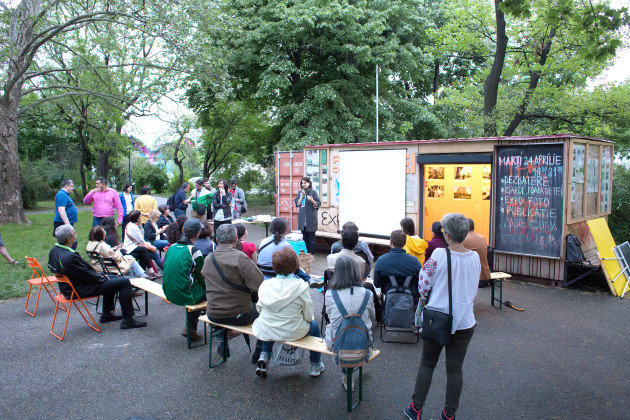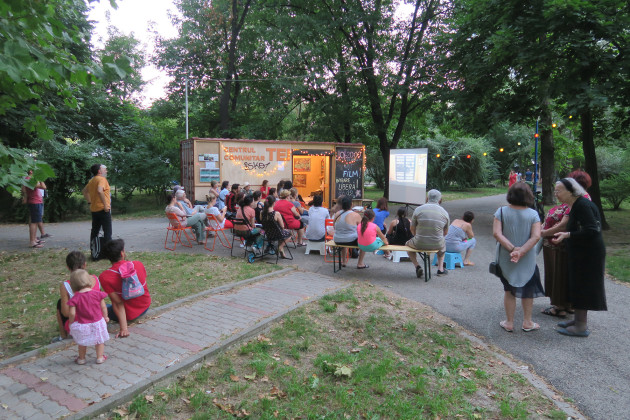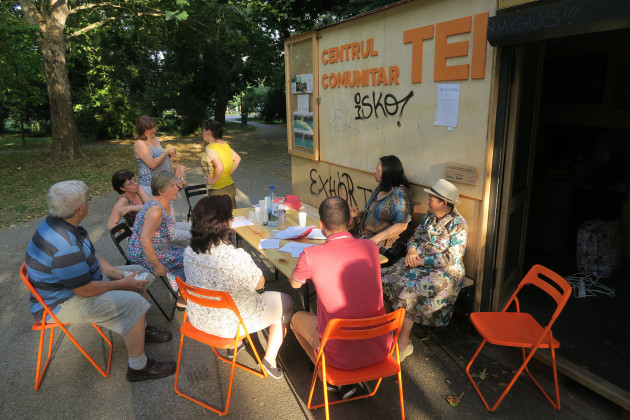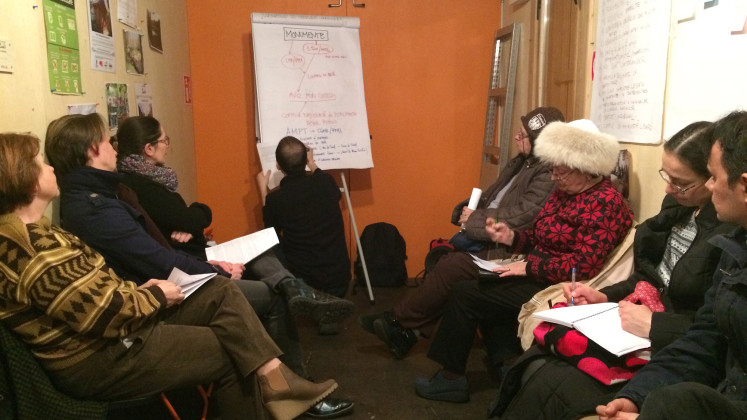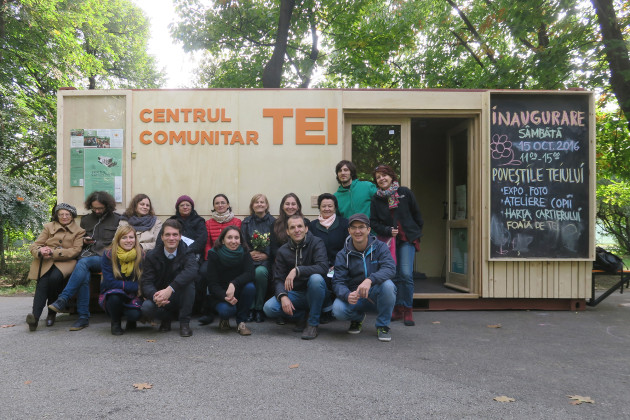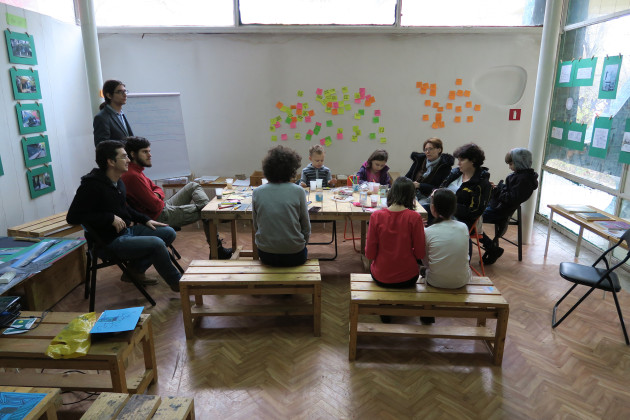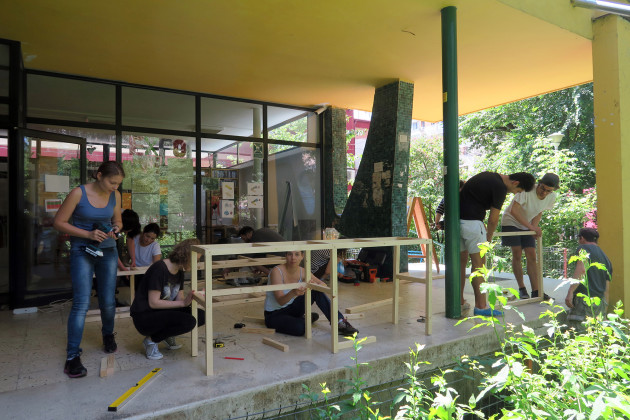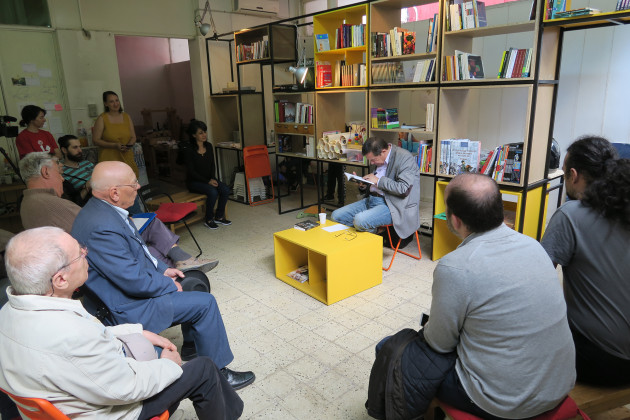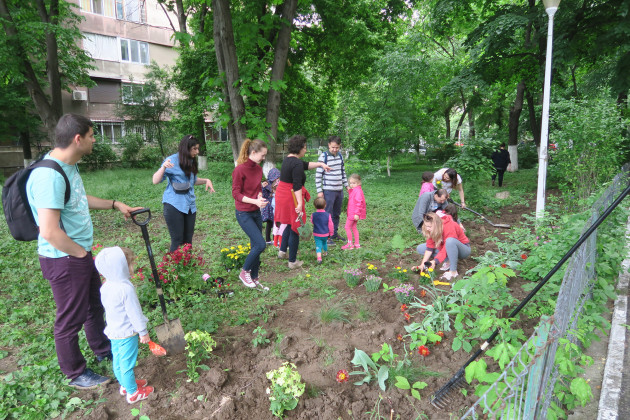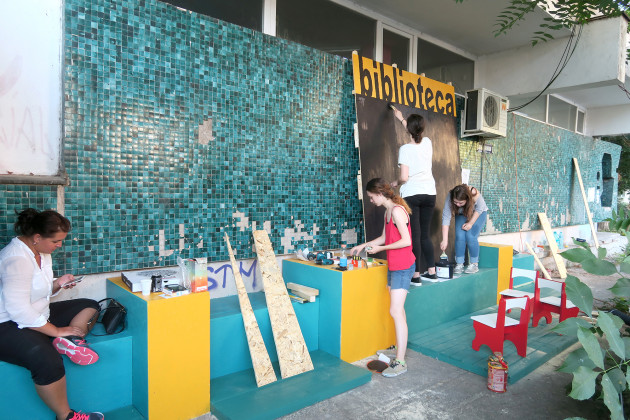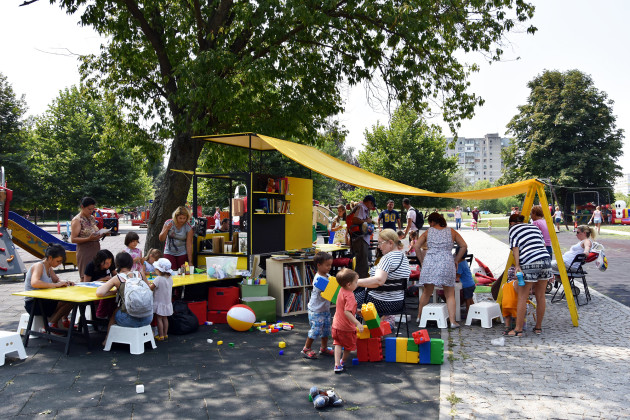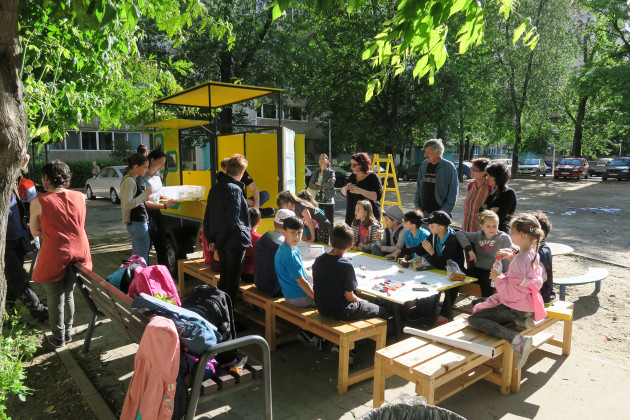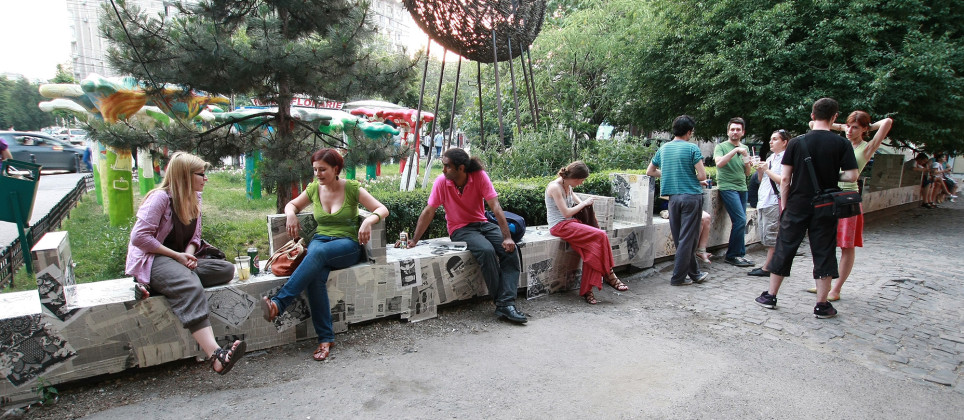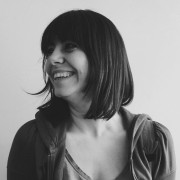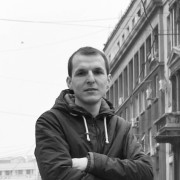Knowledge Transfer By Co-design
Hulya Ertas in conversation with Cristi Borcan of studioBASAR on the potentials of urban commons and co-design processes with communities in the specific context of Bucharest.
HE: Your practice emphasizes co-creation, co-production and collective ownership. These are possible through empowerment of communities, not only in terms of their daily practices but also in their capacities for space making. What are your experiences in transferring and sharing the architectural knowledge to the communities you work with?
Cristi Borcan: It is indeed something that preoccupies us and when I say us, I refer not only to architects but also to the different other professionals that were part of the teams we worked with, like landscape architects, anthropologists, sociologists and community organizers. Architects in particular assume that we are the experts who know everything about everything. During our projects we discovered that when you go out in a real context and be in contact with a real community, most of the times the community knows better what it needs. Of course, as professionals we also know a lot (by having specific skills) but people have a great variety of needs and knowledge. We also discovered that the transfer of knowledge works also in the other direction. We learned a lot. For instance, when we were involved with the Tei Community Center project in Bucharest we made the technical drawings so that the project would be approved by the authorities. During the project people from the community told us many small details, such as what kind of paint to use or where and how large the windows should be. I think that when you share knowledge during the process of making space, both sides learn a lot. Afterwards we started the process of slowly exiting the project and empower the community to decide about the space they will continue to use by themselves.
HE: Have you experienced the community taking over and transforming the structure in the Tei Community Center?
CB: Not yet. They still expect our presence there. And the continuity of the project depends on the internal organization of the civic group (Lacul Tei Civic Initiative Group). For organization related to space-making and space-managing I think they are not there yet. But in other ways they organize many events by themselves which is a good thing for the group and for the community. When they have some space related problems, they contact us. In that regard the transfer is not yet complete.
HE: Is that the direction you would like to go?
CB: Yes, we would like to go in that direction, but it is still very hard. Constantin Petcou and Doina Petrescu from Atelier d’Architecture Autogéré say, as the name of their practice suggests, that architecture and space at some point can be self-managed. For Tei Community Center we aim to reach that point but we are not there yet. Nonetheless I think this is a very important issue because in the end cities are made by all of us. Each one of us has different capabilities but, as you also emphasized in your question, to make the transfer of knowledge in multiple ways with different actors is a hard task.
HE: Your work is very much Bucharest oriented. Especially since the 1990s as a consequence of globalization architectural practices have been involved in international projects, doing projects in contexts that they are not part of. And then there has been a discussion across the dichotomy of local vs global. But it is apparent today that this dichotomy doesn’t work. There are too many problems on the global scale and some potentials on the local impact. So how does this scaling work in your practice?
CB: Scaling is indeed a problem. David Harvey says that the huge global problems cannot be solved with small local approaches. He proposes more integrated and complex thinking. Of course, it is a problem which we also noticed from our practice. We did a lot of small projects, actions, activities and alike but at one point we realized that it is not enough to do small actions. Scaling horizontally is important, like building networks. Of course, these are important but the local context of Paris or London is totally different from the local context of Bucharest or Istanbul. We can build networks but at the same time we need a vertical scaling, not in terms of mass-scale but going through different levels of urban systems. For instance, in Bucharest's case, scaling vertically means to work with public authorities or to convince them that what we try to do is very important for the community. In our practice now we notice that this might be a way to go. Maybe a middle way is good as in every aspect of life. But in my view, one should try to work with the state instead of going around or excluding it.
HE: When we come back to question of your projects being mostly in Bucharest: you didn’t work on other parts of Romania, did you?
CB: Well, we did that but we prefer to work in Bucharest. We worked in different parts of Europe or elsewhere, like for the Chicago Architecture Biennial. But the main focus of our actions is Bucharest. I think I know why you ask this question. If we work very local, we can solve issues for a specific local community. But how can we make a bigger difference? What can we do for changing the system?
HE: I think this question is obsolete. It positions itself in the dichotomy of local and global although today both are more intertwined. I agree with problem of the scale, that small interventions cannot formulate an answer to bigger problems as they can not accumulate, they cannot be added to each other for a huge solution and also because you don’t work in a hierarchical system. I am trying to find out if there meanwhile could be another way of dealing with the local and global.
CB: That is what Atelier d'Architecture Autogeree try to do with trans-local networks. Perhaps this is a way indeed. For now, we try to focus on the local context and scaling it vertically and horizontally.
HE: In a post-communist context where the memories of forced collectivization are so fresh it must be hard to reactivate the collective feeling in the community. Does this challenge have an impact on your efforts to redefine your role as an architect?
CB: This relates also to the previous question about local-global context. So we live in a post-communist country and as I said before, this is very different than in Paris or London. Indeed, the memories of forced collectivization are very fresh in people’s minds, in the general socio-cultural context of Eastern Europe. This is also very visible within architectural practices. A lot of architects from the fall of communism onwards oriented their practices only to private commissions because in communism there were no private offices and everyone worked forcedly for the state. Still today many architects work only for private enterprises. There are very few architects working for the public administration, employed by the state. This is a general problem in the world. This influences a lot of what we do. If you work with the state you (supposedly) do projects for general public. If you work for a private commission like a house, you work for an individual or a family. But between the general public and the individual private there are also other scales. There are different groups, collectives and communities. When I think about it now again, I realize that we want to work in this middle section of the society. Sometimes we work with civic groups whose members do not have easy access to architectural services.
HE: Also while working with the communities the architectural service is not predefined like it usually is when working for the public or private.
CB: True, and it changes through the process. People are different, so communities are different. Our role, our aim at that point is to work with the communities and not for them. When you work with communities you are on the same level with them. I think it is a good role for architects. To be on the same level with the people they work with. The sharing of knowledge is much easier when you relate to each other horizontally. We can also speak about co-authorship because architects are usually very self-oriented. For us it is important that these are projects built together with the community.
HE: There is this discussion on the topic of commons being beyond the state and the market while the state is needed for permissions and the market for funding. How sustainable is this model according to you?
CB: This is a hard question because commons as a concept but also as a real situation in the city is very difficult to define. It has many meanings and interpretations. For now, let's just say that a middle way between the state and the market within our Bucharest context can maybe work. On the one hand the state has a lot of control. On the other hand, there is a common characteristic of the commons, namely it is anti-capitalistic, taking the resource from the danger of privatization to put it back into the hands of the community. I think we will keep on working with this model of between the market and the state but we are just at the beginning.
HE: And also the commons is a prefigurative practice. So you try to generate an environment you would like to live in.
CB: And then you change it along the process I imagine. Urban commons is a new concept in general. When we learned about it we discovered that some parts of our projects could be defined as urban commons. For instance some of the installations in our City School project can be defined as commons. These are some installations as spatial resources. There is a community taking care of them. And this community is running a commoning practice with specific rules. We didn’t define this from the beginning. Yet again for our post-communist, Romanian, Bucharest context I think commons can be a model even for sustainable community regeneration and development.
HE: Could you tell a bit more about the City School? The network of teams which made many things possible in that project is really inspiring.
CB: City School is a programme we started in 2015, with the idea to take the students out of the laboratory environment of the architectural school. We wanted to put them into the real context of the city, in contact with a real community. Another idea of the project was interdisciplinarity because architecture education is very self-oriented. But when you are in the real life working as an architect you are confronted with a lot of multi- and inter-disciplinarity. We chose public libraries as the subject of the school. Bucharest Metropolitan Library is the last network of public resources that is still spread around the city and more importantly, survived the privatization wave that followed the fall of communism. So we worked in one of the branches of the Library in the highly dense Militari neighborhood of Bucharest. There were two editions of the City School. First edition was asking the question of how this small space of the library could be transformed into a community space. We had the chance that the director of the library was very open to this idea. Together with the students and informed by the community we transformed the interior of the library. The main outcome of this process was an open space, free of shelves and furniture, where the community of future users could decide what activities could happen.
In the second edition we went out of the space of the library and to the community. The students mapped the spaces around the library, talked to the inhabitants and finally selected two locations that are typical to these collective housing neighborhoods: an asphalt paved space adjacent to the library and a green space in front of a nearby block of flats. Collaborating and negotiating with the users, the students imagined solutions of opening these underused public spaces. We also prepared a third edition, which is supposed to be about the garden in front of the library but we don’t have the funds yet.
HE: Making a commons architecture project requires much more diverse set of skills than the classical ones like architectural drawings, statics, building physics etc. In that regard I think that going out of the studio and working on real projects might be the only way of teaching commons.
CB: Yes, that is why we worked for the City School project with many other people from anthropology and landscape design schools. We noticed in many projects that we as architects lack a lot of tools. This relates also to your previous question about the role of the architect. In urban projects you need a lot of knowledge, not only from the community but also from other people with different backgrounds.
HE: There is always a dark side of the story as well, like squats becoming gentrified through anti- squats, counter movements of anti-capitalist actions have a risk of being fed back into the capitalist system. Do you think there would be some ways to fight this? Perhaps through non- commodified infrastructures like your project Trailer for Research and Activation?
CB: Yes, we try to make non- commodified (infra)structures. For years we have been designing and making mobile infrastructures and offering them for free to people and organizations, even to state institutions which didn’t have the resources to activate the public spaces. But I don’t know if this would be an answer to how to make non-commodified infrastructure because we have to think about who is paying for it. You can build non-commodified infrastructure but at the end you have to ask also who gave you that money to build it.
HE: Which tools, methods can be used to ensure participation, that it is diverse and inclusive? Do you have specific methods to make sure that it is not a fake participatory process, to meet with not only resource-rich people who have the time but also with the marginalized groups?
CB: One way for us was to share the power of knowledge from the beginning, in other words, not to approach a community with preconceived ideas and ready-made solutions. Even just by asking people what they know and what they need, we try to involve them from the very beginning of a project. Regarding the diversity and inclusivity, I have to say that it is actually a problem. The civic groups in Bucharest are mostly composed of middle-class, middle-age citizens. We haven’t yet found a method to engage other groups of people, people with hard social problems let's say. But I have to also tell you that when we worked on the Tei Community Center project, we didn’t work on the community organization part, what relates to your mention of playing different roles sometimes. There was a NGO of community organizers (CeRe: Resource Center for public participation), most of them coming from a background of anthropology, sociology and social sciences. While working with community organizers we discovered that they have different methodologies on how to approach also marginalized or diverse groups. So the NGO took that role within the Tei Community Center project and it was very interesting for us to see their way of working. They were very open to invite and reach really a big diversity of people including gypsies, poor people, old people; they just went out and talked to them.
HE: There is a lot of emphasis on the temporary use in the urban commons due to their in-limbo situations that have the potential to start something new. And most of the times, what is considered as temporary can stay longer than the initial plan.
CB: Temporariness is a very important concept that we work with. We were influenced by our context, because Romania is a country in a continuous transition for the last thirty years. But again there is the question of how you define the temporariness. A bench we built, that was meant to be temporary, survived for almost ten years. Perhaps in our context urban commons for instance can be defined as a temporary process, from the beginning.
HE: At the same time I consider this temporariness as a weak spot for power of transformation, it is there and disappears again. It stays as a reaction to something.
CB: Indeed, following the reaction it is gone and the system continues the same way. That’s when we go back to the first ideas about how we can change the system. Can we do that through the small projects, actions, initiatives or should we try it from within that very system? I am sorry that I cannot give you a very sharp answer on that. The commons projects are still ongoing and we ask ourselves a lot of questions and we don’t have yet all the answers.
Related Content:
-

Energy Self-Sufficiency for Public Activation
-
Urban Development through the Culture of Volunteering
Bilgen Coşkun and Dilek Öztürk talked with sociologist and Living Cities member Jennie Björstad, about social inclusion, “yes culture” and the role volunteers for urban development.
-
Participatory Dialogues for Urban Design
Bilgen Coşkun and Dilek Öztürk talked with architects and urban planners Christelle Lahoud, Pontus Westerberg and Klas Groth from UN-Habitat about designing smart cities through participatory planning approaches.
-
Participatory Design is the New Black
Cities are complex organisms that are able to develop themselves at an incredible speed and in different conditions.
-
Collaborative Work Through Community Building and the Other Way Around
The fourth edition of Glocal Camp was held in Gran Canaria and Tenerife between 4-16 April. And here is an insider review
-

Urban Laboratory
-

Green Extension
-
Inter-scale Negotiations
Ezgi Tezcan has talked to Peter Barber over social housings shaped under neoliberal urban politics and possibilities of participatory architecture.
 06.05.2020
06.05.2020



